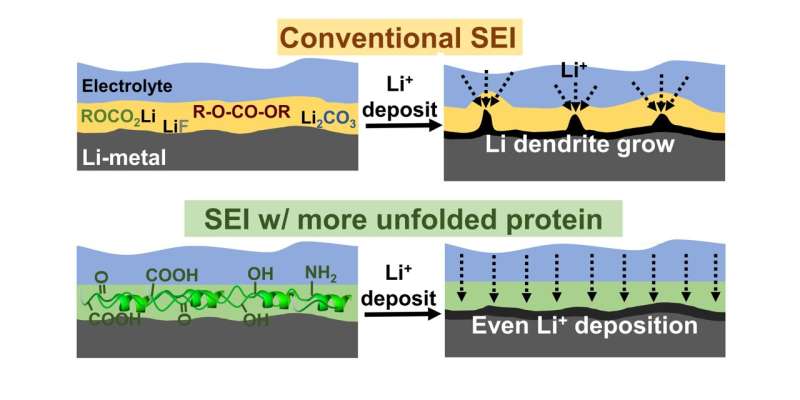Protein-modified solid electrolyte interphase formation and evolution in Li metal batteries

Numerous studies focused on developing safe and long-term cycling Li-metal batteries (LMBs) have been reported. However, transferring these high-performing LMBs from lab-scale to industrial-scale production remains challenging. Most studies on LMBs are limited to solving the issue of Li dendrite formation via an in situ or ex situ formed layer on the Li anode, while the formation and evolution of the solid electrolyte interphase (SEI), through imitating the practical production process of LMBs, are rarely considered.
Recently, Chenxu Wang and co-workers (from Washington State University) published a research article entitled "Protein modified SEI formation and evolution in Li metal batteries" in the Journal of Energy Chemistry.
Therein, the authors reported the formation of protein-modified SEIs on Li anodes at different stand-still temperatures. Additionally, the evolution of the protein-modified SEIs was investigated by controlling the duration of the stand-still process. In particular, the evolution of the chemical components and wetting behavior of the modified SEIs with an electrolyte were studied by controlling the conditions of the stand-still process.
It was found that the heat treatment used for protein denaturation led to more unfolded chain structures, which was confirmed by the simulation study. The resulting heat-treated-zein-modified (H-zein-modified) SEI demonstrated better wetting behavior and faster SEI formation than the unheated sample (U-zein).
Furthermore, the symmetrical Li|Li cell with the H-zein-modified SEI exhibited a longer cycle life (360 h) than the U-zein-modified SEI (260 h). Moreover, the symmetrical LiFePO4/Li cell with the H-zein-modified SEI presented a more stable long-term cycling performance with a higher capacity retention (70%) than that of the cell with the U-zein-modified SEI (42%) after 200 cycles.
Therefore, high and stable formation rates could be achieved with the H-zein-modified SEI after a short-time stand-still process. As a result, the Li anode with the H-zein-modified SEI achieved stable long-term cycling performance in symmetrical Li|Li and full cells.
More information: Chenxu Wang et al, Protein-modified SEI formation and evolution in Li metal batteries, Journal of Energy Chemistry (2022). DOI: 10.1016/j.jechem.2022.06.017
Provided by Chinese Academy of Sciences





















